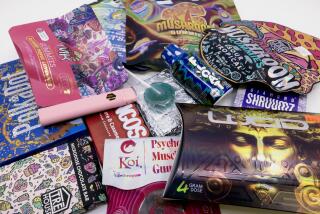Ailments related to synthetic marijuana likely to rise, experts say
It’s been labeled incense, potpourri and herbal smoking blend, and it’s sold over the counter with brand names like Black Mamba, K2 and Spice.
Though synthetic marijuana has, until recently, triggered relatively few emergency room admissions, a sudden surge in illnesses at hospitals in Denver may presage similar outbreaks in other parts of the country, experts say.
In an editorial published Wednesday in the New England Journal of Medicine, experts warned that synthetic cannabinoids appeared to be growing more potent.
“Although the effects of exposures to first-generation synthetic cannabinoids are largely benign, newer products have been associated with seizures, ischemic stroke and cardiac toxicity, possibly due to potency,” authors wrote.
The products feature dried herbs and spices that have been sprayed with chemicals that cause a marijuana-type high when smoked. The drugs, which are sold in legal retail outlets, are often labeled “not for human consumption.”
Despite laws prohibiting the sale of synthetic marijuana, the products remain widely available.
Colorado-area emergency rooms noticed a sudden surge in admissions related to the drug from Aug. 24 to Sept. 19.
Dr. Andrew Monte, the paper’s lead author and an assistant professor in emergency medicine and medical toxicology at the University of Colorado School of Medicine, said 263 people visited area emergency rooms, mostly young men.
Symptoms included altered mental status, irregular heart beat and seizures. “The care of most patients was managed in the emergency department, but seven patients required admission to intensive care units,” authors wrote.
The outbreak then ended abruptly. Only 10 cases were reported at the same hospitals from Sept. 13 to Oct. 25.
“These substances are not benign,” Monte said in a prepared statement. “You can buy designer drugs of abuse at convenience stores and on the Internet. People may not realize how dangerous these drugs can be -- up to 1,000 times stronger binding to cannabis receptors when compared to traditional marijuana.”
Hospital staff members and police recovered several brands of the products from the patients and studied them using mass spectrophotometry. The synthetic cannabinoid they found was a molecule called ADB-PINACA, which cannot yet be detected in blood or urine, authors wrote.
“Outbreaks like this are likely to keep happening,” Monte said. “We need better testing to identify these subsatnces, open communication with public health officials when outbreaks occur, and we need to make sure more physicians ask patients the right questions about their drug use.”







